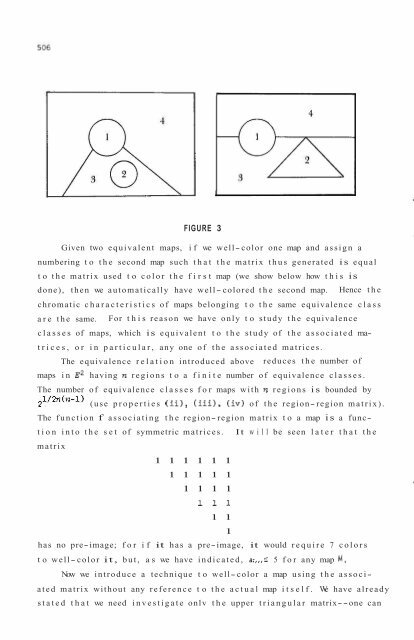Create successful ePaper yourself
Turn your PDF publications into a flip-book with our unique Google optimized e-Paper software.
FIGURE 3Given two equivalent maps, if we well-color one map and assign anumbering to the second map such that the matrix thus generated is equalto the matrix used to color the first map (we show below how this isdone), then we automatically have well-colored the second map.Hence thechromatic characteristics of maps belonging to the same equivalence classare the same.For this reason we have only to study the equivalenceclasses of maps, which is equivalent to the study of the associated ma-trices, or in particular, any one of the associated matrices.The equivalence relation introduced above reduces the number ofmaps in E~ having n regions to a finite number of equivalence classes.The number of equivalence classes for maps with n regions is bounded byl/2n(n-1)(use properties (ii), (iii), (iv) of the region-region matrix).The function f associating the region-region matrix to a map is a func-tion into the set of symmetric matrices.matrix111111111111111I l l111It will be seen later that thehas no pre-image; for if it has a pre-image, it would require 7 colorsto well-color it, but, as we have indicated, a:,,, 5 5 for any map M.<strong>No</strong>w we introduce a technique to well-color a map using the associ-ated matrix without any reference to the actual map itself. We have alreadystated that we need investigate onlv the upper triangular matrix--one canconstruct the triangular matrix by determining, for a particular regioni, the regions with assigned integer greater or equal to i, which havea common border with region i. The well-coloring procedure is as follows:Suppose that we make the first region of color A.first row by A.We then "multiply" theFor the preceding matrix map of Fig. 1 we would obtainA A A O A1111I l l<strong>No</strong>w investigate the second (ith) region.ond (ith) region of the same color A11J . .We are allowed to make the sec-as the first region (the same coloras the (i - l)st, (i- 2)nd-0-2nd, 1st regions) ONLY if the second (ith)column does not already contain color A (color of (i - l)st, (i - 2)nd- --etc.) We see we cannot use color Aond column already has Aand hence "multiply" the row by B.for the second region since the sec-in It; we must use a different color, say B,We getA A A O AB B B BI l l11Continuing this process we finally obtainA A A O AB B B Bc c c<strong>No</strong>te that in row four we can use color Aagain, since that column doesnot already contain A. This means that region 1 will be made color A;2, B; 3, C; 4, A; 5,WID. If we now go back to the actual map, we see thatit is well-colored.FIGURE 4
















